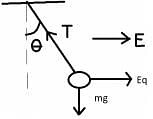Physics: CUET Mock Test - 1 - JEE MCQ
30 Questions MCQ Test - Physics: CUET Mock Test - 1
The amount of force exerted on a unit positive charge in an electric field is known as _____
| 1 Crore+ students have signed up on EduRev. Have you? Download the App |
Electric potential due to a point charge q at a distance r from the point is _______ (in the air).
In series connection of resistors, what happens to the current across each resistor?
The direction of electric field created by a negative charge is _______
Calculate electric potential due to a point charge of 10C at a distance of 8cm away from the charge.
What is the equivalent resistance of series combination of 3 resistors?
Electric field inside a hollow conducting sphere ______
If the force acting on a point charge kept on the axis of an electric dipole is F, what will be the amount of force if the distance of the point charge is doubled from the dipole?
What is the amount of work done to bring a charge of 4 * 10-3C charge from infinity to a point whose electric potential is 2 * 102V?
Identify the combination which is not a series connection.
Electric field due to a uniformly charged hollow sphere at a distance of r (where r is greater than the radius of the sphere) is __________
If electric field intensity at a certain distance from a dipole on its axis is E1 and at the same distance but on the perpendicular bisector of the dipole is E2, then __________
Two point charges 10C and -10C are placed at a certain distance. What is the electric potential of their midpoint?
Three equal positive charges are kept at the corners of an equilateral triangle. What will be the vector sum of the forces acting on the particles?
Two point charges q1 and q2 are situated at a distance d. There is no such point in between them where the electric field is zero. What can we deduce?
Electric field intensity at the center of a square is _____ if +20 esu charges are placed at each corner of the square having side-length as 10 cm.
Pick out the correct statement from the following about parallel combination of resistors.
A ball of 80mg mass and a 2*10-8 charge is hung with a thread in a uniform horizontal electric field of 2*104V/m. What is the angle made by the thread with vertical?
If an electric dipole is placed in a uniform electric field ______ will act on the dipole.
Find the electric field intensity at 10cm away from a point charge of 100 esu.
A small charge q is rotated in a complete circular path of radius r surrounding another charge Q. The work done in this process is _________
Give the dimensional formula for magnetic permeability of free space.
Under which of these conditions, the torque acting on the current carrying loop is minimum?




 Substituting the values, we get potential=
Substituting the values, we get potential=  Though in practice, this huge value of electric potential is not present.
Though in practice, this huge value of electric potential is not present. Therefore the electric field is proportional is (1/(r2)) (if r > radius of the sphere). But if r < radius of the sphere the electric field will be zero i.e. electric field inside a hollow sphere is always zero.
Therefore the electric field is proportional is (1/(r2)) (if r > radius of the sphere). But if r < radius of the sphere the electric field will be zero i.e. electric field inside a hollow sphere is always zero. Therefore field intensity at the center due to a single charge is =
Therefore field intensity at the center due to a single charge is =  dyne/esu. But the fields due to the four charges are equal and are at perpendicular to each other. So the fields balance each other and the net electric field at the center will be equal to zero.
dyne/esu. But the fields due to the four charges are equal and are at perpendicular to each other. So the fields balance each other and the net electric field at the center will be equal to zero.















